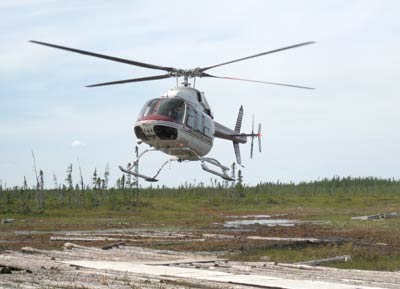 The Geological Survey of Canada (GSC) and its provincial counterpart, the Ontario Geological Survey (OGS), are teaming up to help exploration companies in the McFaulds Lake-Ring of Fire area of Northern Ontario zero in on the region’s mineral wealth.
The Geological Survey of Canada (GSC) and its provincial counterpart, the Ontario Geological Survey (OGS), are teaming up to help exploration companies in the McFaulds Lake-Ring of Fire area of Northern Ontario zero in on the region’s mineral wealth.
Part of the federal government’s $12 million Targeted Geoscience Initiative #4, the research is aimed at gaining a better understanding of the different ore systems in the region and allowing companies to target their drilling more effectively.“We still don’t understand the deposit environments in the McFaulds Lake area,” said Alan Galley, minerals director with the Geological Survey of Canada. “There’s a large chromite resource. There are nickel, copper and platinum group elements. There are volcanogenic massive sulphides with copper, zinc and precious metals and there are shear hosted gold systems, so we have various types of systems and a lot of their characteristics overlap with one another, making it difficult to understand which system you’re dealing with.”
Work will be focused on refining alteration models to vector more efficiently.
Mineral deposits are usually formed by heated, metallic-bearing fluids flowing through the rock, explained Galley.
“They have a chemistry that is quite different from the rock they’re passing through. Some of the characteristics of that fluid get transferred to the rock as secondary minerals, so you end up with an assemblage of secondary minerals that is very distinctive.”
These signatures, or halos of indicators, vary depending on the temperature of the fluid and provide geologists with clues about how far away they are from an orebody.
Research will also focus on clues offered in the glacial debris that covers Northern Ontario and the Canadian Shield “to see what kind of signatures from hidden deposits we can find within the overlying sediment and how we can use those as vectors,” said Galley.
Additional work will focus on the Thunder Bay-Nipigon area and banded iron formations in the Pickle Lake area of northwestern Ontario.
The Targeted Geoscience Initiative #4 was announced in the federal budget of March 2010 and has a mandate to develop new geoscience knowledge in support of deep exploration across Canada. The $12 million allocated is to be spent over a two-year period. The amount budgeted for Ontario will be considerably less than $12 million, but could by supplemented by funding from the OGS.
The research program was developed with input from each affected province and is due to be approved at a meeting of the National Geological Survey Committee at the PDAC in March.


.jpg;w=120;h=80;mode=crop)